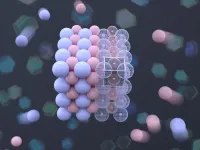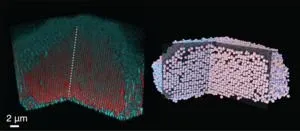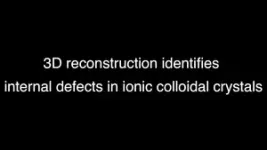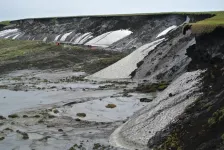(Press-News.org) A team of New York University researchers has created a new way to visualize crystals by peering inside their structures, akin to having X-ray vision. Their new technique—which they aptly named “Crystal Clear”—combines the use of transparent particles and microscopes with lasers that allow scientists to see each unit that makes up the crystal and to create dynamic three-dimensional models.
“This is a powerful platform for studying crystals,” says Stefano Sacanna, professor of chemistry at NYU and the principal investigator for the study, published in the journal Nature Materials. “Previously, if you looked at a colloidal crystal through a microscope, you could only get a sense of its shape and structure of the surface. But we can now see inside and know the position of every unit in the structure.”
Atomic crystals are solid materials whose building blocks are positioned in a repeating, orderly fashion. Every now and then, an atom is missing or out of place, resulting in a defect. The arrangement of atoms and defects is what creates different crystalline materials—from table salt to diamonds—and gives them their properties.
To study crystals, many scientists, including Sacanna, look to crystals composed of miniscule spheres called colloidal particles rather than atoms. Colloidal particles are tiny—often around a micrometer in diameter, or dozens of times smaller than a human hair—but are much larger than atoms and therefore easier to see under a microscope.
A see-through structure
In their ongoing work to understand how colloidal crystals form, the researchers recognized the need to see inside these structures. Led by Shihao Zang, a PhD student in Sacanna’s lab and the study’s first author, the team set out to create a method to visualize the building blocks inside a crystal. They first developed colloidal particles that were transparent and added dye molecules to label them, making each particle possible to distinguish under a microscope using their fluorescence.
A microscope alone wouldn’t allow the researchers to see inside a crystal, so they turned to an imaging technique called confocal microscopy, which uses a laser beam that scans through material to produce targeted fluorescence from the dye molecules. This reveals each two-dimensional plane of a crystal, which can be stacked on top of each other to build a three-dimensional digital model and identify the location of each particle. The models can be rotated, sliced, and taken apart to look inside the crystals and see any defects.
In one set of experiments, the researchers used this imaging method on crystals that form when two of the same type of crystals grow together—a phenomenon known as “twinning.” When they looked inside models of crystals having structures equivalent to table salt or an alloy of copper and gold, they could see the shared plane of the adjoined crystals, a defect that gives rise to these particular shapes. This shared plane revealed the molecular origin of twinning.
Crystals in motion
In addition to looking at static crystals, this new technique allows scientists to visualize crystals as they change. For example, what happens when crystals melt—do particles rearrange, and do defects move? In an experiment in which the researchers melted a crystal with the structure of the mineral salt cesium chloride, they were surprised to find that the defects were stable and did not move around as expected.
In order to validate their experiments on static and dynamic crystals, the team also used computer simulations to create crystals with the same characteristics, confirming that their “Crystal Clear” method accurately captured what is inside crystals.
“In a sense, we’re trying to put our own simulations out of business with this experiment—if you can see inside the crystal, you may not need simulations anymore,” jokes Glen Hocky, assistant professor of chemistry at NYU, a faculty member in the Simons Center for Computational Physical Chemistry at NYU, and the study’s co-corresponding author.
Now that scientists have a method for visualizing the inside of crystals, they can more easily study their chemical history and how they form, which could pave the way for building better crystals and developing photonic materials that interact with light.
“Being able to see inside crystals gives us greater insight into how the crystallization process works and can perhaps help us to optimize the process of growing crystals by design,” adds Sacanna.
Additional study authors include Adam Hauser and Sanjib Paul of NYU. The research was supported by the US Army Research Office (award number W911NF-21-1-0011), with additional support from the National Institute of Health (R35GM138312), and used NYU IT High Performance Computing resources, including those supported by the Simons Center for Computational Physical Chemistry at NYU (grant number 839534).
END
Scientists develop “x-ray vision” technique to see inside crystals
Developing transparent particles and imaging their positions, researchers shed light on never-before-seen interiors of crystalline structures
2024-06-03
ELSE PRESS RELEASES FROM THIS DATE:
Arctic melting heavily influenced by little-studied meteorological phenomena, find scientists led by UMass Amherst
2024-06-03
AMHERST, Mass. – A team of scientists led by François Lapointe, a research associate at the University of Massachusetts Amherst, has combined paleoclimatic data from the last 2,000 years with powerful computer modeling and in-the-field research on lake sediments and tree rings to show that an understudied phenomenon, known as atmospheric blocking, has long influenced temperature swings in the Arctic. As temperatures warm due to climate change, atmospheric blocking will help drive ever-wilder weather events. The study focused ...
Where do Nextdoor communities exist—and what do these communities talk about?
2024-06-03
Nextdoor is the world’s largest hyperlocal social media network, used by 13% of American adults. Yet little is known about the make-up of the actual neighborhoods—numbering approximately 220,000 across the United States—in which these accounts exist and what people in those communities talk about on the platform.
To address our limited understanding of this population, a team of New York University and University of Michigan researchers generated a demographic portrait of communities in which Nextdoor neighborhoods exist, the presence of public agencies in those communities, and what topics are most often discussed. Using U.S. Census data, other publicly available ...
Thawing permafrost: Not a climate tipping element, but nevertheless far-reaching impacts
2024-06-03
Permafrost soils store large quantities of organic carbon and are often portrayed as a critical tipping element in the Earth system, which, once global warming has reached a certain level, suddenly and globally collapses. Yet this image of a ticking timebomb, one that remains relatively quiet until, at a certain level of warming, it goes off, is a controversial one among the research community. Based on the scientific data currently available, the image is deceptive, as an international team led by the Alfred Wegener Institute has shown in a recently released study. According to their findings, there is no single ...
To eliminate COVID-era bloodstream infections in heart, lung patients, Tampa Hospital had to innovate
2024-06-03
San Antonio, Texas – June 3, 2024 – Recognizing an unusual prevalence of bloodstream infections (BSI) that threatened extremely ill patients receiving Extracorporeal Membrane Oxygenation, or ECMO, Tampa General Hospital (TGH) infection preventionists started an intervention that eliminated these infections completely from their 18-bed Cardiothoracic Intensive Care Unit (CTICU).
At the APIC 2024 Annual Conference, presenters from the 1,000-bed, tertiary care, academic medical system reported on how they reduced bloodstream infections in ECMO patients from a rate of 36% in October 2021 to a rate of 0% in April 2022. This rate was sustained for seven ...
New pathways for treating never-smoker lung cancer revealed
2024-06-03
The primary cause of lung cancer is smoking. However, the incidence of lung cancer among never-smokers has been steadily increasing, especially among women. While approximately 80% of never-smoking lung cancer patients are prescribed targeted therapies that focus on mutations in proteins such as EGFR and ALK, the remaining patients often receive cytotoxic chemotherapy with high side effects and relatively low response rates, highlighting the urgent need for targeted therapies.
Dr. Lee Cheolju's ...
Efficient CO2 conversion to fuels and chemicals using ionic liquid electrolyte
2024-06-03
Converting CO2 into fuel and chemicals using electricity, also known as electrochemical conversion of CO2, is a promising way to reduce emissions. This process allows us to use carbon captured from industries and the atmosphere and turn it into resources that we usually get from fossil fuels.
To advance ongoing research on efficient electrochemical conversion, scientists from Doshisha University have introduced a cost-effective method to produce valuable hydrocarbons from CO2. The study was made available online on 17 May 2024 and formally published in the journal Electrochimica Acta on 20 July 2024. The research team, led by Professor Takuya Goto and including Ms. Saya Nozaki from ...
Intoxication without alcohol: Auto-brewery syndrome
2024-06-03
How can someone have alcohol intoxication without consuming alcohol? Auto-brewery syndrome, a rare condition in which gut fungi create alcohol through fermentation, is described in a case study in CMAJ (Canadian Medical Association Journal) https://www.cmaj.ca/lookup/doi/10.1503/cmaj.231319.
“Auto-brewery syndrome carries substantial social, legal, and medical consequences for patients and their loved ones,” writes Dr. Rahel Zewude, University of Toronto, with coauthors. “Our patient had several [emergency department] visits, was assessed by internists and psychiatrists, and was certified ...
HPV-based screening can help eliminate cervical cancer
2024-06-03
Implementing human papillomavirus (HPV)-based screening in British Columbia could eliminate cervical cancer in the province before 2040, according to a modelling study in CMAJ (Canadian Medical Association Journal) https://www.cmaj.ca/lookup/doi/10.1503/cmaj.231682.
More than 90% of cervical cancer cases worldwide are caused by 9 types of high-risk HPV. The World Health Organization and the Canadian Partnership Against Cancer (CPAC) have both set targets to eliminate cervical cancer by 2040, defined as an annual rate of less than 4 per 100 000 women.
The Pap test has been the primary screening ...
New biomarkers will enable personalised influenza vaccination schedule
2024-06-03
Berlin, Germany: While influenza infection is a significant public health threat, causing serious illness in between three and five million people worldwide per year and leading to about up to 650,000 deaths, the effectiveness of influenza vaccines varies considerably between individuals depending on vaccine types and individual circumstances. A person’s ability to resist infection (host immunity) plays an important role in this. Now, researchers have developed a way of classifying host immunity in individuals, which may lead to the early identification of those who will not respond well to a regular vaccine schedule and therefore ...
Understanding how abnormal embryos self-correct may provide women with a better chance of IVF pregnancy
2024-06-03
Berlin, Germany: Aneuploidy (the presence of an abnormal number of chromosomes) in embryos is a major cause of impaired embryo development, leading to conditions such as Down syndrome, as well as to pregnancy loss. The transfer of such embryos in women undergoing IVF is therefore usually avoided because of unfavourable pregnancy outcomes. But mosaic embryos, comprising both genetically normal and abnormal cells, can result in perfectly normal babies. Now, researchers have been able to understand how these mosaic ...
LAST 30 PRESS RELEASES:
The perfect plastic? Plant-based, fully saltwater degradable, zero microplastics
Bias in data may be blocking AI’s potential to combat antibiotic resistance
Article-level metrics would provide more recognition to most researchers than journal-level metrics
Satiety’s little helper: Protein that supports appetite regulating protein identified
UF dives deep into predicting storm damage with computer models
A stormy ocean voyage yields insights on the global carbon cycle
Scientists identify first non-coding gene that controls cell size
Demonstration of altermagnetism in RuO₂ thin films -- A new magnetic material for the AI era
Penn researchers awarded $25M to conduct trial using smartphones to fight heart disease
PCORI awards funding for new patient-centered healthcare research
Exploring the origins of the universe: 145 low-noise amplifiers complete ALMA telescopes
Empress cicada wings help illuminate molecular structure
Using sound waves to detect helium
Time burden in patients with metastatic breast and ovarian cancer from clinic and home demands
Researchers discover bias in AI models that analyze pathology samples
Scientists ID potential way to prevent brain injuries from triggering Alzheimer's
MASTER 2nd Open Call: Execution period kick-off
Algae for health in food and pharma
Advanced microrobots driven by acoustic and magnetic fields for biomedical applications
Chicago health information leader recognized for raising CPR readiness and blood pressure awareness
The Intimate Animal, a new book from Kinsey Institute Executive Director Dr. Justin Garcia
When blue-collar workers lose union protection, they try self-employment
New video dataset to advance AI for health care
MEA-based graph deviation network for early autism syndrome signatures in human forebrain organoids
New modeling approach sheds light on rare gut disease
Study documents potentially hazardous flame retardants in firefighter gear
Can certain bacteria regulate aging of the immune system and its related alterations?
AI model helps diagnose often undetected heart disease from simple EKG
There are fewer online trolls than people think
Cell membrane fluctuations produce electricity
[Press-News.org] Scientists develop “x-ray vision” technique to see inside crystalsDeveloping transparent particles and imaging their positions, researchers shed light on never-before-seen interiors of crystalline structures






